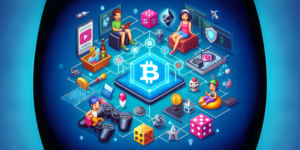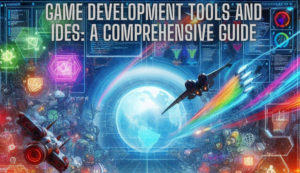Introduction to Game Development: Unveiling the Art of Digital Worlds

Introduction: In a world where pixels paint stories and virtual realms come alive, game development stands as a testament to human creativity and innovation. In this blog post, we embark on a journey through the intricacies of game development, unraveling the magic that transforms ideas into immersive interactive experiences. Whether you’re a curious enthusiast or an aspiring developer, this guide will serve as your compass in navigating the vast terrain of game creation.
1. The Essence of Game Development
At its core, game development is the fusion of art, technology, and storytelling, culminating in digital environments that captivate and engage players. This multidisciplinary field weaves together diverse elements, including programming, design, art, sound, and more, to create the dynamic tapestry of interactive games.
2. The Game Development Odyssey: A Glimpse of the Journey
Conceptualization: Every game begins with a seed of imagination. This phase involves brainstorming game concepts, mechanics, and themes that will shape the player’s experience.
Design: With the concept in hand, designers meticulously craft the blueprint of the game. From gameplay mechanics to level layouts and character attributes, every facet is defined in detail.
Development: The design leaps from paper to screen as programmers bring it to life through code. This stage involves selecting a programming language and a game engine—a software framework that streamlines development—and creating the interactive foundation of the game.
Art and Animation: Game artists infuse visual splendor into the project, creating characters, objects, environments, and user interfaces. These digital artisans breathe life into the pixels, shaping the aesthetic identity of the game.
Sound and Music: The symphony of gaming is composed in this phase. Sound designers craft aural landscapes—sound effects that mimic reality and melodies that evoke emotions, enriching the player’s journey.
Testing and Quality Assurance: The game is put through rigorous trials to identify bugs, glitches, and areas for improvement. This iterative process refines the gameplay and ensures a polished final product.
Release and Distribution: As the finishing touches are applied, the game is readied for distribution across platforms—consoles, PCs, mobile devices, or the web—making it accessible to players worldwide.
3. The Ensemble of Game Development Roles The game development orchestra features diverse talents, each contributing a unique note:
Game Designer: This visionary architect designs the gameplay mechanics, intricacies of levels, and overarching player experience.
Game Programmer: Coding virtuosos translate designs into reality, writing the logic that powers the game and ensures seamless execution.
Game Artist: Visual sorcerers conjure characters, environments, and interfaces, breathing artistic life into the virtual world.
Game Sound Designer: The auditory maestro creates soundscapes that heighten immersion, crafting sound effects and melodies that resonate with players.
Producer/Project Manager: This conductor orchestrates the development process, overseeing timelines and resources and ensuring harmony among team members.
4. The Engine Behind the Scenes: Choosing a Game Engine A game engine is the canvas upon which the masterpiece is painted. Unity, Unreal Engine, Godot—these are the instruments that empower developers with tools, assets, and capabilities to bring their visions to life.
5. Programming the Play: Languages of Game Development Programming languages are the syntax of interaction in the digital realm. Three prominent ones are:
C#: Wielded in Unity, it scripts gameplay mechanics, user interfaces, and interactions.
C++: Is the backbone of Unreal Engine, it empowers high-performance games with its computational might.
Python: Is the jack-of-all-trades, often used for rapid prototyping and scripting in various game engines.
6. Navigating the Terrain: Basic Game Development Concepts
Game Loops: At the heart of every game beats the game loop—a continuous cycle that updates game logic, rendering, and player input.
Sprites and Textures: Visual elements, known as sprites and textures, are the building blocks of the game’s visual identity, displayed on the screen as characters, objects, and backgrounds.
Collision Detection: The intricate dance of collision detection ensures that characters and objects interact believably within the game world.
Input Handling: The orchestra responds to the conductor’s baton—player inputs—translating into character movements, actions, and interactions.
Conclusion: Crafting Digital Worlds, One Line of Code at a Time As we draw the curtain on this introductory journey into game development, the allure of the digital frontier shines brighter than ever. It’s a realm where pixels evolve into breathtaking landscapes, where storytelling is interactive, and where imagination knows no bounds. Whether you’re nurturing the dream of crafting your own games or seeking a deeper understanding of the creative forces that shape your favorite pastime, game development is an enchanting odyssey that melds technology, artistry, and passion into a symphony of play. So, embrace this creative expedition, for with each line of code, you’re not just developing games—you’re crafting worlds.
AID Bangalore offers world-class Game Programming courses that teach you the skills you need to create your own games. From programming to design, art, and animation, our courses will give you the knowledge and hands-on experience you need to succeed in the game development industry. If you’re interested in a career in game development, AID Bangalore is the perfect place to start. Contact us today to learn more about our Game Programming courses.
Similar Articles
-

Blockchain Gaming: Where Fun Meets Decentralization 04-12-2024
Introduction The gaming industry has always been a hotbed of innovatio
-

The Art of Product Design: Creating Timeless Toys 03-19-2024
Crafting Memories, One Toy at a Time: This is a journey of innovation
-

ACES: Revolutionizing Color Management in Visual Effects 02-19-2024
ACES, which stands for the Academy Color Encoding System, is a standar
-

Game Development Tools and IDEs: A Comprehensive Guide 02-15-2024
Game development is a complex and multifaceted process that requires a
